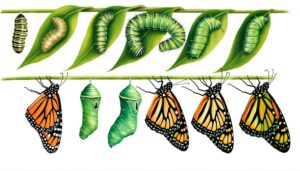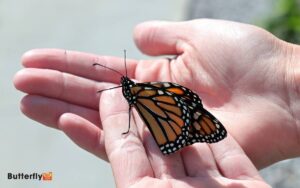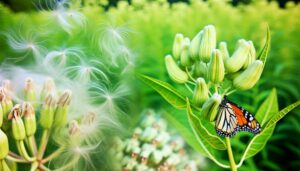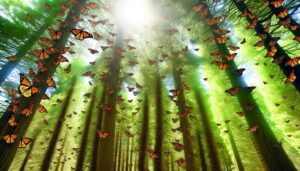A Picture of a Monarch Butterfly
A picture of a monarch butterfly reveals an exquisite example of nature's complexity, characterized by vivid orange wings adorned with black veins and white spots along the margins. These patterns serve critical functions, including aposematism to warn predators of their toxicity, and aiding in thermoregulation.
The butterfly exhibits a finely structured exoskeleton, specialized compound eyes, and a proboscis adapted for nectar feeding. During migration, monarchs traverse vast distances across North America, showcasing innate navigational prowess.
Observing a monarch up close provides insights into its life cycle, habitat requirements, and conservation challenges. Continue to uncover the intricate dynamics of this iconic species.
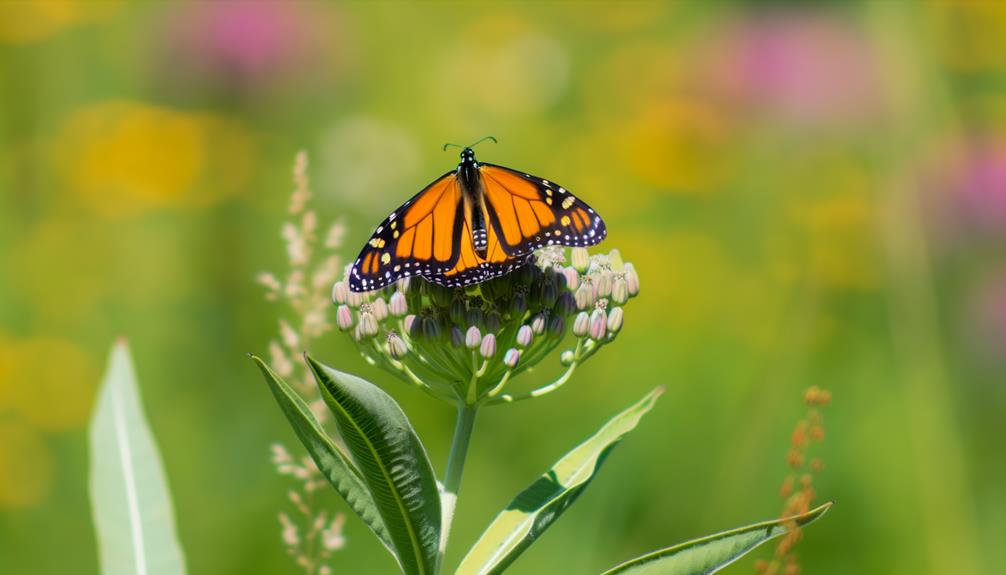
Key Takeaways
- Monarch butterflies have vibrant orange wings with black and white patterns, signaling toxicity to predators.
- Monarchs feature an exoskeleton, compound eyes, and a proboscis for nectar feeding.
- Their migration spans thousands of miles across North America to Mexico and California.
- Monarchs depend on milkweed plants for laying eggs and larval development.
Anatomy of a Monarch
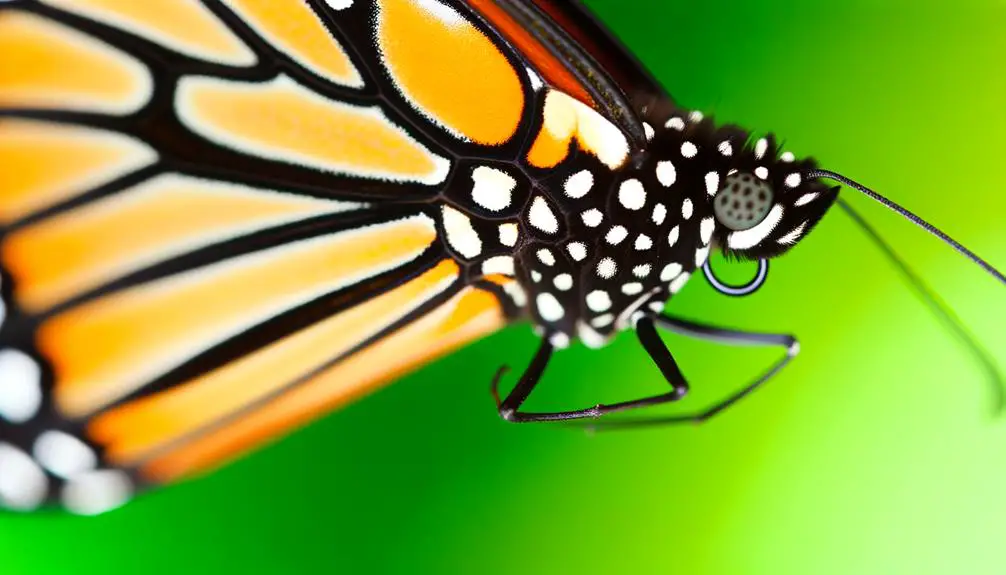
The anatomy of a monarch butterfly (Danaus plexippus) is complex and highly specialized, featuring distinct morphological adaptations that facilitate its survival and migratory behavior.
The monarch's exoskeleton provides structural support and protection against predators and environmental stressors. Its compound eyes, comprising thousands of ommatidia, afford a broad visual field, essential for navigation.
The proboscis, a coiled tube-like mouthpart, enables efficient nectar feeding. Monarchs possess three pairs of jointed legs for clinging to surfaces and dual pairs of wings, with the forewings larger than the hindwings, optimized for sustained flight.
Antennae equipped with chemoreceptors aid in detecting pheromones and environmental cues. Internally, the tracheal system guarantees efficient gas exchange, while the reproductive organs are adapted for prolific breeding.
Vibrant Wing Patterns
Beyond the anatomical features, the monarch butterfly's vibrant wing patterns play a significant role in its survival, offering both camouflage and warning signals to potential predators.
These striking patterns are not merely ornamental; they serve critical biological functions. The bright orange and black coloration is a classic example of aposematism, a defense mechanism where vivid colors signal toxicity. Additionally, these patterns help in thermoregulation, aiding in the absorption of solar radiation.
Key aspects of these wing patterns include:
- Aposematism: The vivid colors warn predators of the butterfly's toxicity, deterring attacks.
- Mimicry: Some species mimic monarch wing patterns to gain protection from predators.
- Thermoregulation: Darker pigments absorb sunlight, assisting in maintaining ideal body temperature.
This intricate interplay of colors and patterns exemplifies nature's complexity.
Monarch Migration Routes
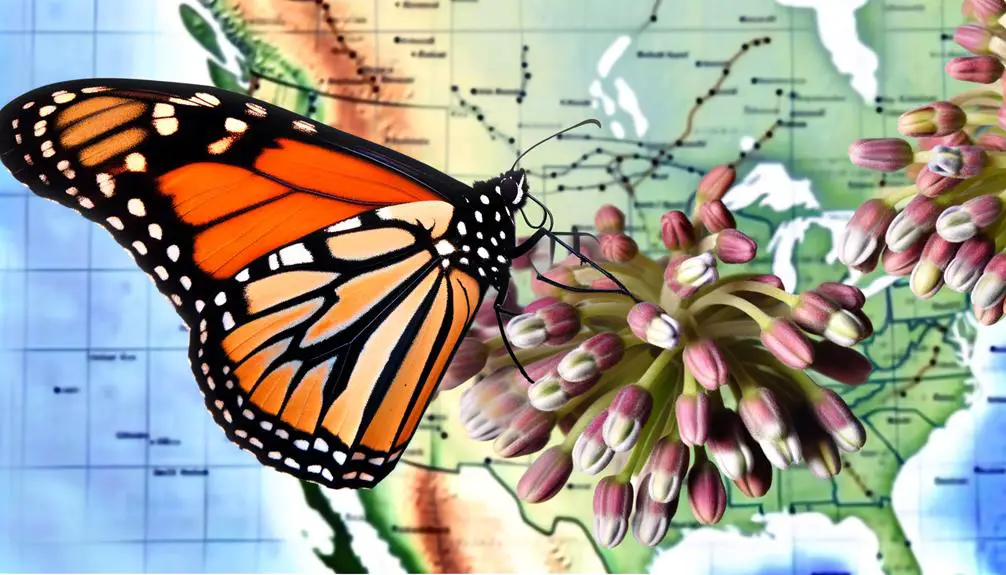
Each year, millions of monarch butterflies commence on an extraordinary migration journey spanning thousands of miles across North America. This migration is a complex phenomenon driven by environmental cues such as temperature and daylight.
Monarchs east of the Rocky Mountains travel to the Transvolcanic Belt of central Mexico, specifically the Oyamel fir forests. Meanwhile, those west of the Rockies head to coastal California, especially the Monterey Peninsula.
Utilizing innate navigational skills, these butterflies traverse diverse habitats, often facing perilous conditions. Their migration is not only a proof of their resilience but also a critical ecological event.
Understanding these routes is essential for conservation efforts, as habitat loss and climate change threaten their migratory success and survival.
Life Cycle Stages
Understanding the migratory behavior of monarch butterflies necessitates an examination of their life cycle stages, which are intricately linked to their survival and reproductive success.
The monarch butterfly undergoes a complex metamorphosis with four distinct stages:
- Egg: Monarch butterflies lay their tiny, white eggs on the undersides of milkweed leaves. These eggs hatch in approximately 3-5 days.
- Larva (Caterpillar): Upon hatching, the larvae feed voraciously on milkweed, undergoing five instars over a span of about two weeks.
- Pupa (Chrysalis): The caterpillar transforms into a chrysalis, a stage lasting around 10-14 days, during which remarkable morphological changes occur, culminating in the emergence of the adult butterfly.
These stages are critical for the monarch's migration and reproduction.
Host Plants and Habitat

The survival and reproductive success of monarch butterflies are heavily dependent on the availability of specific host plants, primarily milkweed species, which provide the necessary nutrients for larvae and suitable habitats for egg-laying. Monarchs exhibit a strong preference for various milkweed species, dependent on regional availability and environmental conditions. The selection of host plants directly influences larval development and survival rates.
| Region | Common Milkweed Species | Habitat Type |
|---|---|---|
| Eastern U.S. | Asclepias syriaca | Meadows, fields, and roadsides |
| Western U.S. | Asclepias speciosa | Grasslands and open woodlands |
| Mexico | Asclepias curassavica | Tropical and subtropical regions |
The habitat quality, including the abundance and health of milkweed, is essential for sustaining monarch populations, highlighting the importance of conservation efforts targeting these environments.
Predators and Threats
Monarch butterflies face numerous predators and threats that greatly impact their populations, ranging from natural enemies like birds and insects to human-induced challenges such as habitat loss and pesticide exposure.
Predation primarily involves species like:
- Birds: Remarkably, the Black-headed Grosbeak and the Black-backed Oriole have adapted to tolerate the toxic cardenolides present in Monarchs.
- Insects: Certain wasps and parasitoid flies target Monarch larvae, considerably reducing survival rates.
- Human Activities: Deforestation and agricultural expansion destroy essential milkweed habitats, while pesticide use contaminates both food sources and breeding grounds.
These factors collectively contribute to the declining Monarch populations, necessitating thorough strategies to mitigate these threats.
Understanding these elements is vital for implementing effective conservation measures.
Conservation Efforts
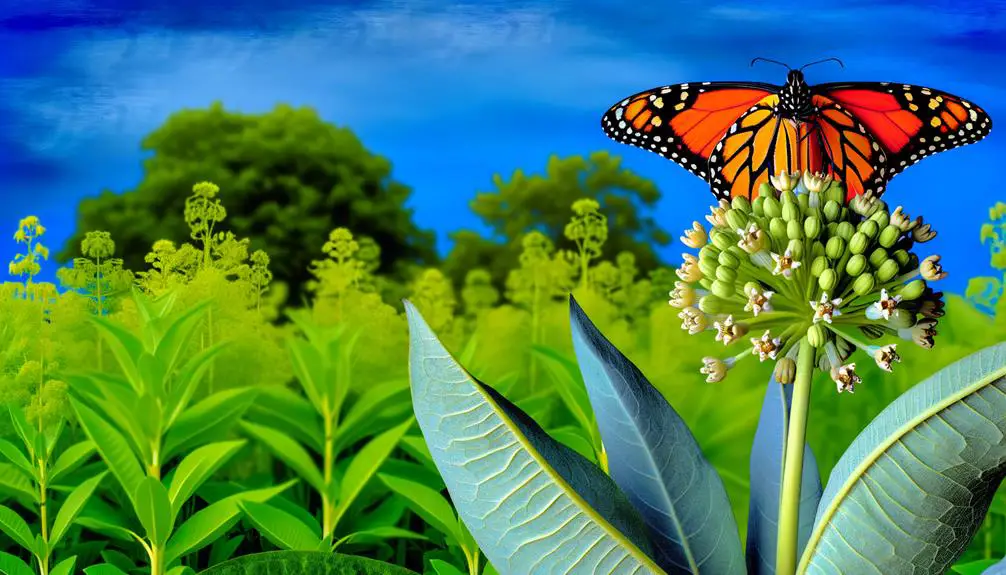
Effective conservation efforts for the Monarch butterfly necessitate a multifaceted approach that addresses both habitat restoration and the reduction of pesticide use.
Key strategies include the planting of milkweed, crucial for Monarch larval development, and nectar-rich flowers to support adult butterflies.
The implementation of pesticide-free zones is essential, as chemical exposure disrupts their reproductive cycles and diminishes population viability.
Additionally, the establishment of protected migratory corridors guarantees safe passage during their extensive journeys.
Scientific monitoring and data collection are indispensable for evaluating the success of these initiatives.
Community involvement and educational outreach further bolster conservation by fostering public awareness and participation.
Such thorough efforts are critical for sustaining the Monarch butterfly, a species that symbolizes ecological resilience and freedom.
Monarchs in Culture
Interwoven into the fabric of various cultures, Monarch butterflies have served as potent symbols of transformation, endurance, and the delicate balance of ecosystems. These lepidopterans hold significant cultural meanings that reflect their unique biological traits and migratory patterns.
- Transformation: In many indigenous cultures, the Monarch's metamorphosis from caterpillar to butterfly is emblematic of personal and spiritual growth.
- Endurance: Their arduous migration journey, spanning thousands of miles, symbolizes resilience and the triumph of the spirit.
- Ecological balance: The Monarch's dependence on milkweed and its role in pollination highlight the intricate interdependencies within ecosystems, reminding us of the fragility and interconnectedness of our natural world.
These cultural representations underscore the Monarch's profound impact beyond its biological significance.
Photography Tips
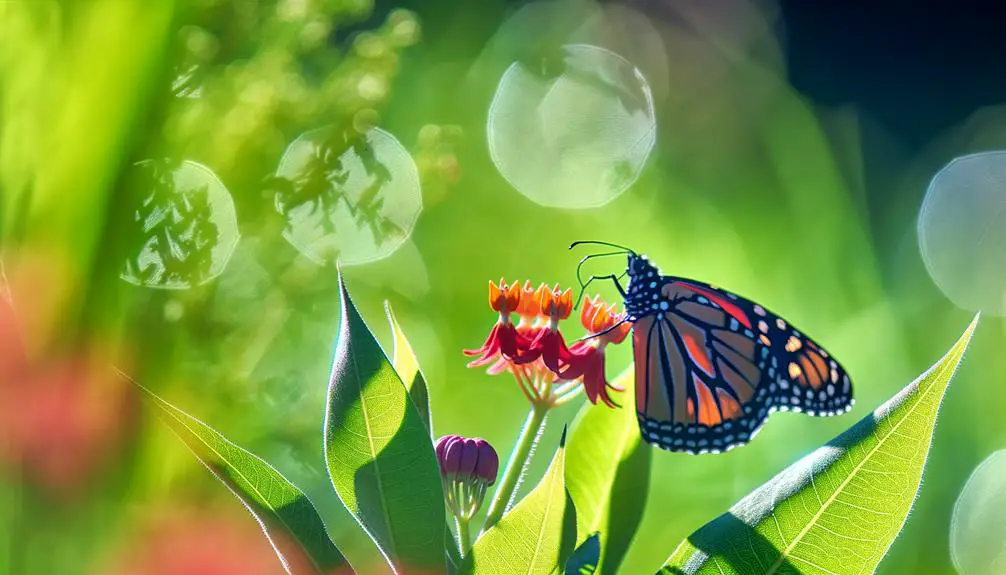
Capturing the intricate beauty of monarch butterflies necessitates attention to camera settings, lighting conditions, and composition techniques.
Ideal settings often include a high shutter speed and macro lens to achieve sharp, detailed images.
Additionally, shooting during early morning or late afternoon provides soft, natural light that enhances the vibrant colors and delicate patterns of the monarch's wings.
Ideal Camera Settings
Selecting the ideal camera settings for photographing Monarch butterflies requires a meticulous balance of aperture, shutter speed, and ISO to capture their delicate beauty in varying light conditions. Each component plays an essential role in ensuring the sharpness, clarity, and vibrancy of your images.
Aperture (f/5.6 – f/8): A moderate aperture provides a sufficient depth of field to keep the butterfly in focus while softly blurring the background, enhancing the subject's prominence.
Shutter Speed (1/1000s or faster): A high shutter speed is necessary to freeze the rapid wing movements and avoid motion blur, ensuring crisp detail.
ISO (100-400): Lower ISO settings minimize noise, preserving the fine details and colors of the butterfly, while higher settings might be necessary in low light.
Best Lighting Conditions
Ideal lighting conditions for photographing Monarch butterflies hinge on leveraging natural light to accentuate their vibrant colors and intricate patterns.
Early morning and late afternoon provide the most favorable light, offering a soft, diffused glow that minimizes harsh shadows and highlights the butterfly's delicate features.
The golden hour, specifically, enhances the warm tones of the Monarch's wings, creating a visually compelling image.
Overcast days are also advantageous, as the cloud cover acts as a natural diffuser, balancing light evenly across the subject.
Photographers should avoid direct midday sunlight, which tends to produce stark contrasts and can wash out the butterfly's vivid hues.
Employing these lighting strategies guarantees the capture of detailed, aesthetically pleasing photos of Monarch butterflies.
Composition Techniques
Mastering composition techniques is essential for creating visually striking photographs of Monarch butterflies, as these methods help to highlight the butterfly's form and environment while maintaining balance and interest within the frame.
Consider the following strategies:
- Rule of Thirds: Position the butterfly off-center to create a dynamic balance, placing key elements along the intersecting lines of a grid divided into nine equal parts.
- Leading Lines: Utilize natural lines such as stems and leaves to guide the viewer's eye towards the Monarch, enhancing focus and depth.
- Depth of Field: Employ a shallow depth of field to isolate the butterfly from its background, creating a pleasing bokeh effect that emphasizes its intricate details and vivid colors.
These techniques collectively enhance the aesthetic and compositional quality of butterfly photography.
Citizen Science Projects
Citizen science projects have become instrumental in monitoring monarch butterfly populations, offering valuable data that contributes to the understanding of their migratory patterns and conservation needs.
These initiatives, such as the Monarch Watch and Journey North, engage the public in collecting data on monarch sightings, breeding locations, and milkweed availability.
By aggregating this information, scientists can analyze trends and identify critical habitats and migration corridors.
The participatory nature of these projects empowers individuals to contribute meaningfully to ecological research, fostering a deeper connection to biodiversity.
Analyzing data from diverse geographic regions enhances the robustness of scientific models, facilitating targeted conservation efforts.
Consequently, citizen science not only augments traditional research but also democratizes data collection, promoting collaborative environmental stewardship.
How to Attract Monarchs
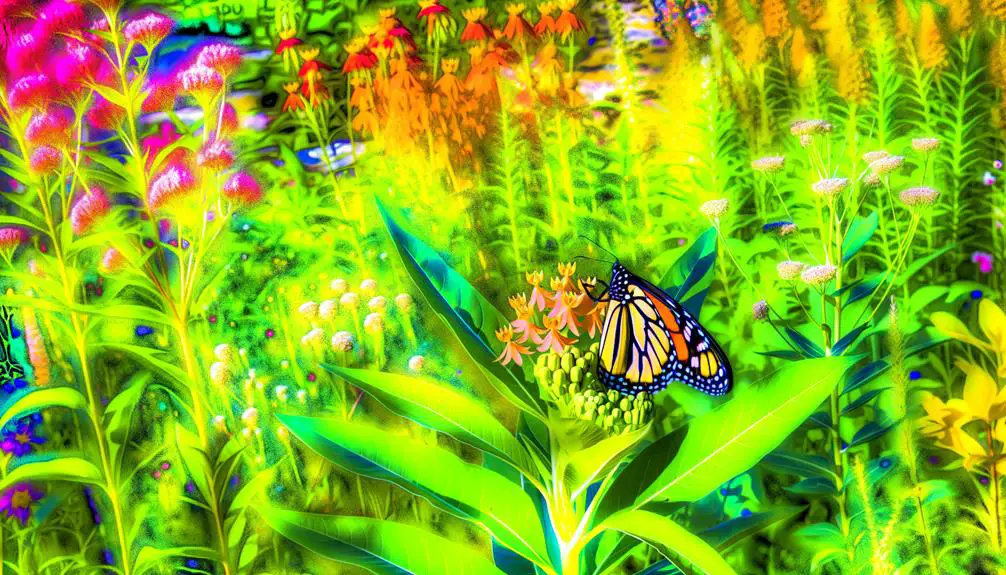
Attracting monarch butterflies to your garden involves creating a habitat that provides essential resources such as nectar-rich flowers, milkweed for larval development, and suitable microclimates for shelter and breeding. Guaranteeing the presence of these elements enhances the likelihood of monarch visits.
Key strategies include:
- Plant Milkweed: Monarch larvae exclusively feed on milkweed. Planting native species ensures caterpillar sustenance and supports their lifecycle.
- Offer Nectar Sources: Adult monarchs require nectar from flowers such as zinnias, coneflowers, and lantanas. A diverse array of blooming plants ensures a continuous food supply.
- Create Microclimates: Provide areas with sun and shelter. Monarchs need sunny spots for basking and protected areas from wind and predators for breeding.
Implementing these strategies fosters an environment conducive to monarch populations.
Conclusion
Despite the monarch butterfly's fragile appearance, its intricate anatomy and vibrant wing patterns reveal a marvel of evolutionary design.
The meticulously mapped migration routes and complex life cycle stages underscore a resilience that belies its delicate form.
Ironically, the monarch's survival hinges on specific host plants and habitats, which are increasingly compromised by human activity.
Yet, it remains a cultural icon and a subject of citizen science projects, demonstrating humanity's paradoxical capacity for both destruction and conservation.


